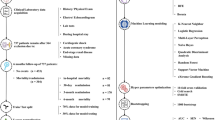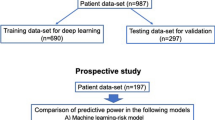Abstract
Background
Mechanical ventilation (MV) is widely used to relieve respiratory failure in patients with congestive heart failure (CHF). Prolonged MV (PMV) is associated with a poor prognosis. We aimed to establish a prediction model based on machine learning (ML) algorithms for the early identification of patients with CHF requiring PMV.
Methods
Twelve commonly used ML algorithms were used to build the prediction model. The least absolute shrinkage and selection operator (LASSO) regression was employed to select the key features. We examined the area under the curve (AUC) statistics to evaluate the prediction performance. Data from another database were used to conduct external validation.
Results
We screened out 10 key features from the initial 65 variables via LASSO regression to improve the practicability of the model. The CatBoost model showed the best performance for predicting PMV among the 12 commonly used ML algorithms, with favorable discrimination (AUC = 0.790) and calibration (Brier score = 0.154). Moreover, hospital mortality could be accurately predicted using the CatBoost model as well (AUC = 0.844). In the external validation, the CatBoost model also showed satisfactory prediction performance (AUC = 0.780), suggesting certain generalizability of the model. Finally, a nomogram with risk classification of PMV was shown in this study.
Conclusion
The present study developed and validated a CatBoost model, which could accurately predict PMV in mechanically ventilated patients with CHF. Moreover, this model has a favorable performance in predicting hospital mortality in these patients.




Similar content being viewed by others
Data availability
The data in of this study could be found in https://physionet.org/content/mimiciv/1.0/ and https://physionet.org/content/eicu-crd/2.0/
Code Availability
The code can be available upon reasonable request to the corresponding author.
References
Diseases GBD, Injuries C. Global burden of 369 diseases and injuries in 204 countries and territories, 1990-2019: a systematic analysis for the Global Burden of Disease Study 2019. Lancet. 2020;396:1204–22.
Groenewegen A, Rutten FH, Mosterd A, Hoes AW. Epidemiology of heart failure. Eur J Heart Fail. 2020;22:1342–56.
Braunwald E. The war against heart failure: the Lancet lecture. Lancet. 2015;385:812–24.
La Franca E, Manno G, Ajello L, et al. Physiopathology and diagnosis of congestive heart failure: consolidated certainties and new perspectives. Curr Probl Cardiol. 2021;46:100691.
Alviar CL, Miller PE, McAreavey D, et al. Positive pressure ventilation in the cardiac intensive care unit. J Am Coll Cardiol. 2018;72:1532–53.
Herring AA, Ginde AA, Fahimi J, et al. Increasing critical care admissions from U.S. emergency departments, 2001-2009. Crit Care Med. 2013;41:1197–204.
Pham T, Brochard LJ, Slutsky AS. Mechanical ventilation: state of the art. Mayo Clin Proc. 2017;92:1382–400.
MacIntyre NR, Epstein SK, Carson S, et al. Management of patients requiring prolonged mechanical ventilation: report of a NAMDRC consensus conference. Chest. 2005;128:3937–54.
Lamas D. Chronic critical illness. N Engl J Med. 2014;370:175–7.
Zilberberg MD, Luippold RS, Sulsky S, Shorr AF. Prolonged acute mechanical ventilation, hospital resource utilization, and mortality in the United States. Crit Care Med. 2008;36:724–30.
Seneff MG, Zimmerman JE, Knaus WA, Wagner DP, Draper EA. Predicting the duration of mechanical ventilation. The importance of disease and patient characteristics. Chest. 1996;110:469–79.
Lin WC, Chen CW, Wang JD, Tsai LM. Is tracheostomy a better choice than translaryngeal intubation for critically ill patients requiring mechanical ventilation for more than 14 days? A comparison of short-term outcomes. BMC Anesthesiol. 2015;15:181.
Damuth E, Mitchell JA, Bartock JL, Roberts BW, Trzeciak S. Long-term survival of critically ill patients treated with prolonged mechanical ventilation: a systematic review and meta-analysis. Lancet Respir Med. 2015;3:544–53.
Bzdok D, Krzywinski M, Altman N. Machine learning: supervised methods. Nat Methods. 2018;15:5–6.
Li L, Zhang Z, Xiong Y, et al. Prediction of hospital mortality in mechanically ventilated patients with congestive heart failure using machine learning approaches. Int J Cardiol. 2022;358:59–64.
Johnson ABL, Pollard T, Horng S, Celi LA, Mark R. MIMIC-IV (version 1.0), PhysioNet, 2021.
Pollard TJ, Johnson AEW, Raffa JD, et al. The eICU Collaborative Research Database, a freely available multi-center database for critical care research. Sci Data. 2018;5:180178.
Collins GS, Reitsma JB, Altman DG, Moons KG. Transparent reporting of a multivariable prediction model for individual prognosis or diagnosis (TRIPOD): the TRIPOD statement. BMJ. 2015;350:g7594.
Hunt SA, Baker DW, Chin MH, et al. ACC/AHA guidelines for the evaluation and management of chronic heart failure in the adult: executive summary a report of the American College of Cardiology/American Heart Association Task Force on Practice Guidelines (Committee to Revise the 1995 Guidelines for the Evaluation and Management of Heart Failure): developed in collaboration with the International Society for Heart and Lung Transplantation; Endorsed by the Heart Failure Society of America. Circulation. 2001;104:2996–3007.
Lanks CW, Musani AI, Hsia DW. Community-acquired pneumonia and hospital-acquired pneumonia. Med Clin North Am. 2019;103:487–501.
Khwaja A. KDIGO clinical practice guidelines for acute kidney injury. Nephron Clin Pract. 2012;120:c179–84.
Singer M, Deutschman CS, Seymour CW, et al. The third international consensus definitions for sepsis and septic Sshock (Sepsis-3). JAMA. 2016;315:801–10.
Kok BC, Choi JS, Oh H, Choi JY. Sparse extended redundancy analysis: variable selection via the exclusive LASSO. Multivar Behav Res. 2021;56:426–46.
Lundberg SM, Erion G, Chen H, et al. From local explanations to global understanding with explainable AI for trees. Nat Mach Intell. 2020;2:56–67.
Li L, Jamieson K, Desalvo G, Rostamizadeh A, Talwalkar A. Hyperband: a novel bandit-based approach to hyperparameter optimization. J Mach Learn Res. 2016;18:1-52.
Ferreira FL, Bota DP, Bross A, Melot C, Vincent JL. Serial evaluation of the SOFA score to predict outcome in critically ill patients. JAMA. 2001;286:1754–8.
Le Gall JR, Lemeshow S, Saulnier F. A new simplified acute physiology score (SAPS II) based on a European/North American multicenter study. JAMA. 1993;270:2957–63.
Le Gall JR, Klar J, Lemeshow S, et al. The logistic organ dysfunction system. A new way to assess organ dysfunction in the intensive care unit. ICU Scoring Group. JAMA. 1996;276:802–10.
Zhang Z. Multiple imputation with multivariate imputation by chained equation (MICE) package. Ann Transl Med. 2016;4:30.
Hancock JT, Khoshgoftaar TM. CatBoost for big data: an interdisciplinary review. J Big Data. 2020;7:94.
Prokhorenkova L, Gusev G, Vorobev A, Dorogush AV, Gulin A. CatBoost: unbiased boosting with categorical features. In: Bengio S, Wallach H, Larochelle H, Grauman K, Cesa-Bianchi N, Garnett R (Ed.), Advances in neural information processing systems 31, Curran Associates, Inc., 2018;6638-6648.
Boorsma EM, Ter Maaten JM, Damman K, et al. Congestion in heart failure: a contemporary look at physiology, diagnosis and treatment. Nat Rev Cardiol. 2020;17:641–55.
Alcon A, Fabregas N, Torres A. Pathophysiology of pneumonia. Clin Chest Med. 2005;26:39–46.
Lelubre C, Vincent JL. Mechanisms and treatment of organ failure in sepsis. Nat Rev Nephrol. 2018;14:417–27.
Goetze JP, Bruneau BG, Ramos HR, et al. Cardiac natriuretic peptides. Nat Rev Cardiol. 2020;17:698–717.
Omland T. Advances in congestive heart failure management in the intensive care unit: B-type natriuretic peptides in evaluation of acute heart failure. Crit Care Med. 2008;36:S17–27.
Park KC, Gaze DC, Collinson PO, Marber MS. Cardiac troponins: from myocardial infarction to chronic disease. Cardiovasc Res. 2017;113:1708–18.
Rumbak MJ, Newton M, Truncale T, et al. A prospective, randomized, study comparing early percutaneous dilational tracheotomy to prolonged translaryngeal intubation (delayed tracheotomy) in critically ill medical patients. Crit Care Med. 2004;32:1689–94.
Funding
This project was supported by the High-level Hospital Project of Fuwai Hospital, Chinese Academy of Medical Sciences (2022-GSP-GG-25).
Author information
Authors and Affiliations
Contributions
This study was designed by LL. ZZH, YLX, ZH, SYL, and BT were responsible for data collation and statistical analysis. LL wrote the first draft. YY reviewed and checked the manuscript. All authors read and approved the final manuscript.
Corresponding author
Ethics declarations
Ethics Approval and Consent to Participate
Because the study was an analysis of the third-party anonymized publicly available database with pre-existing institutional review board (IRB) approval, IRB approval from our institution was exempted.
Consent for Publication
All the authors have agreed to publish this article.
Conflict of Interest
The authors declare that the research was conducted in the absence of any commercial or financial relationships that could be construed as a potential conflict of interest.
Additional information
Publisher’s Note
Springer Nature remains neutral with regard to jurisdictional claims in published maps and institutional affiliations.
Supplementary Information
ESM 1
(DOCX 1800 kb)
Rights and permissions
Springer Nature or its licensor (e.g. a society or other partner) holds exclusive rights to this article under a publishing agreement with the author(s) or other rightsholder(s); author self-archiving of the accepted manuscript version of this article is solely governed by the terms of such publishing agreement and applicable law.
About this article
Cite this article
Li, L., Tu, B., Xiong, Y. et al. Machine Learning-Based Model for Predicting Prolonged Mechanical Ventilation in Patients with Congestive Heart Failure. Cardiovasc Drugs Ther 38, 359–369 (2024). https://doi.org/10.1007/s10557-022-07399-9
Accepted:
Published:
Issue Date:
DOI: https://doi.org/10.1007/s10557-022-07399-9




